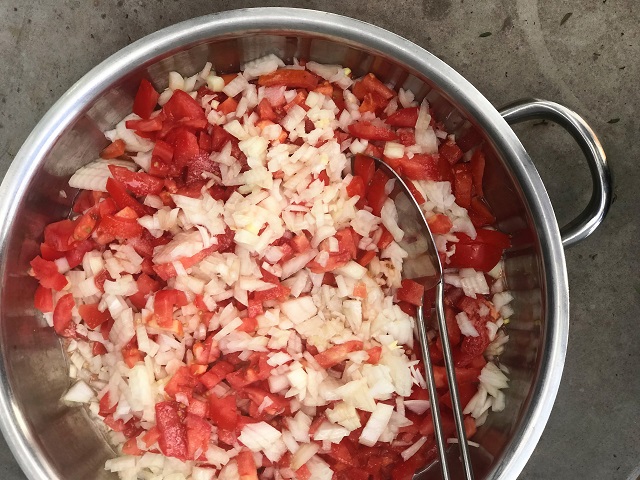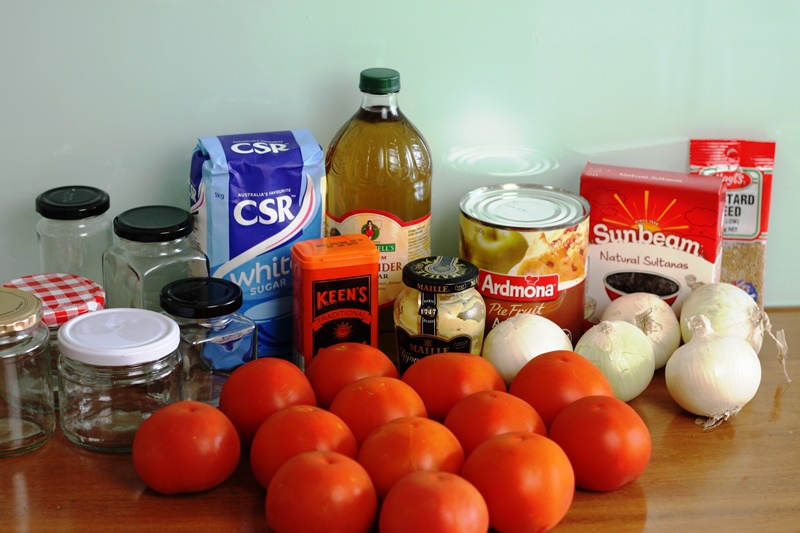- Home
- Blog
- Additives and Labels
- How to create your own Ingredient List
How to create your own Ingredient List
Written by Catherine Saxelby
on Wednesday, 12 November 2014.
Tagged: Food labels, label

Ever wondered how food manufacturers work out their long lists of ingredients? You know those lists of what’s in the packet or jar that are in small font buried somewhere on the back of the label? I decided to work out my own Ingredient List after cooking up a batch of tomato chutney at the end of summer when tomatoes were cheap, ripe and plentiful.
My old-fashioned tomato chutney recipe from the CWA
I started with an old, tried-and-true, recipe for ripe tomato chutney from a Country Women's Association (CWA) cookbook. Except that it didn’t have any quantities the first time I made it up. It just told me to “add enough vinegar to cover” (no help when I need to shop for either a 500 mL bottle or a 2 litre tub) or “top up with water if necessary” (well, how much exactly and how do I tell?).
My 6 steps to creating an Ingredient List
Step 1
After making it up once and measuring and weighing everything, I settled on this recipe based on 2 kg or 4.4 lb of ripe red tomatoes (see picture):
2 kg ripe tomatoes (13 medium tomatoes)
4-5 large onions
1 tablespoon salt *
1 bottle (750 mL) malt vinegar
2 cups white sugar
3 green apples, grated or use 400 g can of pie apple
1 cup sultanas
1 tablespoon plain flour
1 tablespoon curry powder
1 tablespoon Dijon mustard
* by my reckoning, about half the salt is discarded after the initial overnight soak
Step 2
Next I converted all my ingredients from cups and spoons (i.e. domestic or household measures) into a weight in kg or grams or mLs:
| Ingredient | Recipe quantity | Weight |
| Tomatoes | 13 medium | 2 kg |
| Onions | 4-5 white | 500 g |
| Salt | 1 tablespoon | 20 g |
| Malt vinegar | 1 bottle | 750 mL |
| White sugar | 2 cups | 500 g |
| Green apples | 3 | 600 g |
| Sultanas | 1 cup | 150 g |
| Flour | 1 tablespoon | 10 g |
| Curry Powder | 1 tablespoon | 10 g |
| Mustard | 1 tablespoon | 15 g |

Step 3
Then I converted each ingredient into its weight in grams so they were all shown in the SAME unit of weight:
| Ingredient | Recipe quantity | Weight in grams |
| Tomatoes | 14 medium | 2000 |
| Onions | 4 large white | 500 |
| Salt | 1 tablespoon | 20 |
| Malt vinegar | 1 bottle | 750 |
| White sugar | 2 cups | 500 |
| Green apples | 3 | 600 |
| Sultanas | 1 cup | 150 |
| Flour | 1 tablespoon | 10 |
| Curry Powder | 1 tablespoon | 10 |
| Mustard | 1 tablespoon | 15 |
Step 4
Then I sorted all the ingredients into descending order by weight then added them up to give me a grand total of 4555 g:
| Ingredient | Weight in grams |
| Tomatoes | 2000 |
| Malt vinegar | 750 |
| Green apples | 600 |
| Onions | 500 |
| White sugar | 500 |
| Sultanas | 150 |
| Salt | 20 |
| Mustard | 15 |
| Flour | 10 |
| Curry Powder | 10 |
| TOTAL | 4555 |
Step 5
Then I re-wrote this in descending order, starting with the biggest ingredient which is tomatoes:
Tomatoes
Malt vinegar
Green apples
Onions
White sugar
Sultanas
Salt
Mustard
Flour
Curry powder
Step 6
Finally here’s how my Ingredient list above would appear on a label of a jar of the finished chutney:
| Tomatoes (44%), malt vinegar, green apples, onions, sugar, sultanas, salt, mustard, flour, curry powder. |
Tricks for reading this Ingredient List
According to food law, everything must be listed in descending order by weight. Read my eBook on food labels for all these 'rules'. However, unless an ingredient has percentages mentioned after it, we have no way of knowing just by looking, how much of it is present in the product.
For all we know, all the ingredients after tomatoes could be there in the same quantities - unlikely I agree - but possible from the information we have. Let's see what we can actually deduce from this list assuming we don't already know the quantities.
- Tomatoes are the biggest ingredient by weight so they get listed at the beginning. Food law requires me to spell out the percentage of my characterising ingredient (which are the tomatoes in Tomato Chutney) so I need to work out that tomatoes make up 44 per cent of my total ingoing weight. I divided 2000 g of tomatoes by 4555 g of the total to get 43.9 per cent which I’ve rounded up to 44 per cent. In this instance, the List is straightforward.
- Green apples, onions and sugar are present at roughly the same weight which is around 10 per cent of the total – but you can’t tell from the List.
- Sultanas are smaller still, though you can't tell this, or that their percentage is only 3 per cent.
- Salt is where things start to get really small and this usually gives us a clue - as any ingredient AFTER salt is present in tiny amounts. In this case, it’s the mustard, flour and curry powder which are there for a burst of flavour and to thicken.
- There are no preservatives (the vinegar, sugar and salt do that job), no colours and no flavourings.
The bottom line
It takes a bit of work to create an Ingredient List. Here you’ve learnt first-hand how to create one based on a home-made recipe that many of us cook up at the end of the summer season. Remember what an Ingredient List can and can't tell you when you’re next out shopping.
Foodwatch
The Good Stuff
The Boring Stuff
© 2025 Foodwatch Australia. All rights reserved
Website by Joomstore eCommerce






